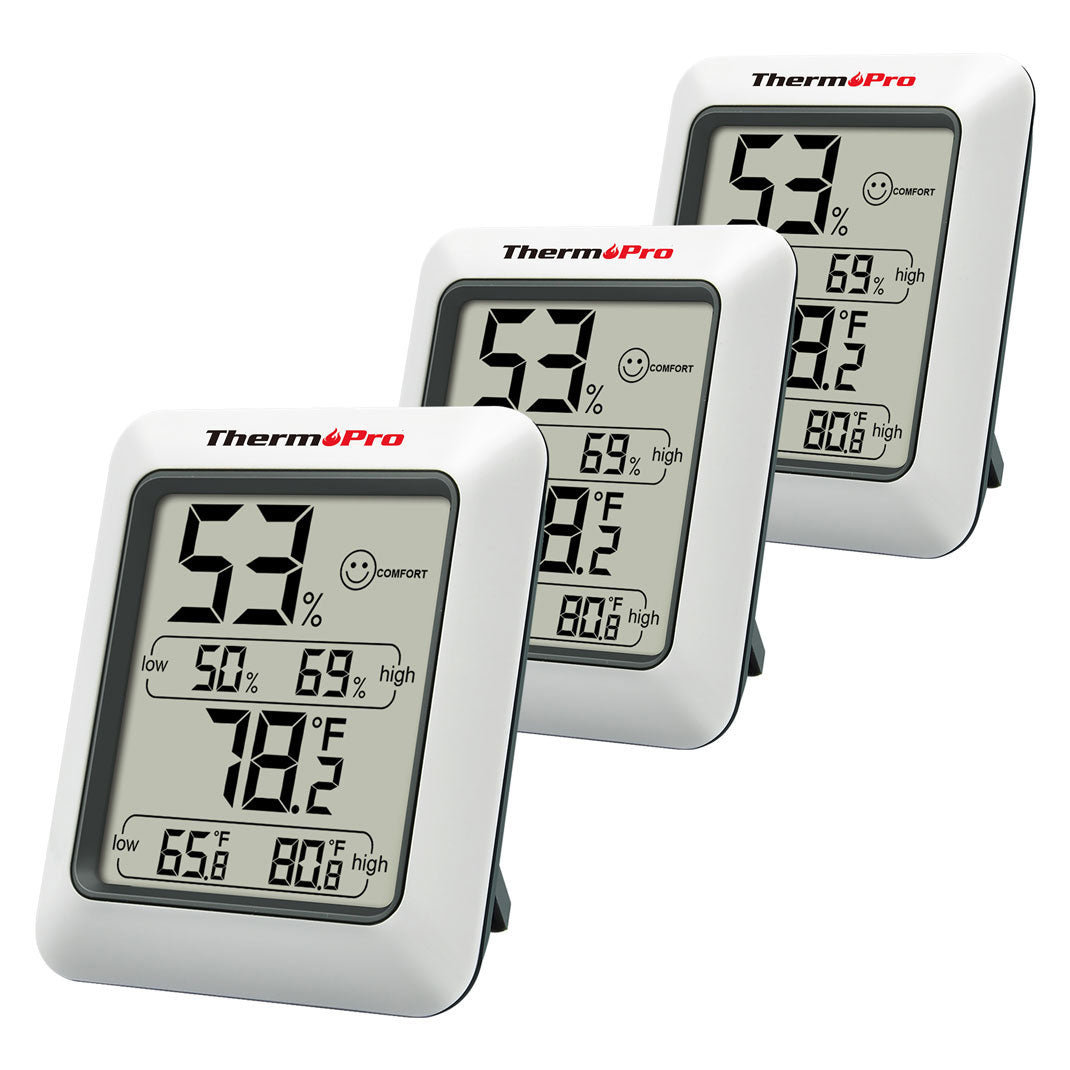Monitoring Temperature and Humidity to Control Mold






 288 Comments
288 Comments
Mold is a pesky substance that is prevalent in many homes, whether the owner is aware or not. The presence of mold can cause household damage and health problems. Throughout this article, we will discuss important concepts of mold, including the proper basement humidity level to prevent mold and the useful way to monitor temperature and humidity level to with the help of thermometer & hygrometer monitor!
What is Mold?
Comprised of small organisms that are found all around us, mold is a type of fungus that plays an important role in our ecosystem. With a duty to break down dead leaves and plants, mold travels through the air in the form of tiny, lightweight spores.
Though we are all exposed to mold daily, the real issue begins when spores land in a damp spot and begin to grow. This can happen even within a home, where the mold spores can then be inhaled causing health problems.
How is Mold Formed?
If mold can comprise our health, shouldn’t we be aware of how to avoid it or prevent its growth? The answer is “yes,” but doing so can be a difficult task. Mold can form in a variety of places through a wide array of methods.
Constant Moisture
Mold thrives in wet conditions with consistent moisture and high humidity. When mold spores encounter a damp surface, they plant themselves and immediately begin to grow. There are three common factors that mold needs to grow: moisture, nutrients, and time. It is inevitable that once mold spores find a dark, damp space in your home that they will begin to thrive and flourish.
Hot Temperature
Your home is the perfect environment for mold to grow in, due to the consistent temperature. Mold likes hot temperatures, which are conveniently generated by constant thermostat monitoring. Most types of mold need a consistent temperature of 70-degree Fahrenheit or more. By regulating the temperature of your home, you can also control the growth and spread of mold within it.
High Humidity
Many species of mold can grow and thrive on humidity alone if the humidity level stays high for a sufficient period of time. Humidity levels typically need to be at 55% or higher before mold begins to grow. Humidity mold can be controlled in your home through proper ventilation, which can reduce the likelihood of mold presence, and using a dehumidifier. A good indicator of high condensation levels within the home is the presence of moisture on windows.

Food Source
A viable food source sets the base that mold requires to grow and spread. Most mold colonies get their food from virtually any type of organic matter. Wood, wall materials, fabric, and indoor plants and soil can all be sources of nutrients for mold. Cabinets, walls, ceilings, and doors that are made with organic substances can all provide material for mold to feed off.
Oxygen
Like all other living organisms, mold needs oxygen in order to maintain life and continue to develop. Mold can grow with even very minimal concentrations of oxygen. This is a very difficult factor in mold growth that is difficult to control, due to our necessity of oxygen within our home. However, on certain surfaces a polymer sealant can be used to reduce or eliminate oxygenation.
Sufficient Time
Fungi grows in multicellular strand structures that are referred to as hyphae. Once a large colony is formed and is visible to the human eye, it is then referred to as mycelium. The small spores that are then produced are easily dispersed by wind and any other disruption. Mold grows by consuming the surface, or organic matter, it is on and then by spreading to increase consumption and growth. This process takes time, but if left uninterrupted can proliferate immensely.
How to Molds Affect People?
Mold can affect individuals in a variety of ways, it will bring mold health issues. Allergies, health conditions, and serious illness can all be caused by different types and quantities of mold. The presence of mold can also affect the structure and appearance of any surface it touches, including homes and the materials within.
Structural Damage to Your Home
Spores and mold thrive on any type of organic, which means that virtually any structure or material within your home is at risk. Mold can create an expensive and bad-smelling mess that is expensive to resolve. Preventive efforts are always optimal. When left unattended, mold can cause damage that is great enough to collapse walls, floors, and ceilings. Though the extent of the damage will not happen overnight, it is important to act before mold growth even gets close to that point.
Adverse Health Effects
One of the most widely discussed consequences of mold growth within a home are the adverse health effects that it can cause. While small amounts of mold likely won’t cause severe health effects, hidden mold is the common culprit. Indoor mold can cause:
- Headaches
- Respiratory Distress
- Skin Irritations
- Fatigue
- Lung Disease
- Cancer
The longer a mold issue goes undetected or unresolved, the more likely you are to experience any combination of these adverse health effects.
Difficulty Breathing and Skin Rash
Mold no only will bring the respiratory, it also will affect your skin. These health effects are easily detected and diagnosed. They are also some of the mildest conditions, so they tend to be the most discussed. These effects can be caused by the presence of mold spores themselves or by coming in contact with larger colonies.
Asthma Attacks
Some individuals may assume that certain symptoms, like coughing, sneezing, or wheezing, are the result of seasonal allergies. When less intense symptoms occur, they can be overlooked until they progress into a large issue. This is often that case with asthma attacks that are mold-induced. Constantly breathing in spores can wreak havoc on your respiratory system.
Humidity Impacts on Mold Formation
What Humidity Does Mold Grow?
As previously mentioned, mold thrives in humidity levels of 55% or more. Humidity levels can vary throughout the house. Common areas of concern are kitchens, bathrooms, and laundry rooms where water is frequently present in large quantities. Increased humidity and mold go hand-in-hand.
Effective Humidity Control
Identify areas in your home with higher humidity levels can help you identify which areas need to be addressed first. Basements can be a common source of mold growth, because they contain all the necessary elements for mold proliferation. Ideally, the basement humidity level to prevent mold growth is between 30-50%. Any level higher than that puts you and your home at risk for mold development.
Temperature Impacts for Mold Formation
While mold grows best in warm areas, it can also thrive in areas of temperature gradient where warm air and cool air meet. Water vapor can condense in these areas, adding humidity for the perfect trifecta of mold growth. Many fungi grow well at 60-80 degrees Fahrenheit, which is also the ideal temperature for humans.
At What Temperature Does Mold Die?
Mold does not do well at temperatures below 60 degrees Fahrenheit or above 80 degrees Fahrenheit. However, it can still grow outside of these temperatures if the conditions are just right. This is what makes it so difficult to ultimately determine what temperature kills mold.
Direct sunlight can help kill mold or prevent it from forming. So, exposing warm areas to sunlight can be helpful.
How to Prevent Mold
Prevention is key. Stopping mold before it has a chance to get a grasp on your home gives you an advantage. Mold remediation is expensive and time-consuming, so partaking in these preventive measures is beneficial in keeping your home mold-free:
1. Controlling humidity levels with the help of indoor thermometer & hygrometer. An exceptional model of this tool is the ThermoPro Indoor Thermometer and Hygrometer. If you need one, here are some choices:
2. Promptly fixing leaky roofs, windows, and pipes. While some of this can be done independently, you may need to seek help from a professional in severe cases.
3. Thoroughly cleaning and drying after flooding. Leaving any moisture in a humid area can generate mold growth.
4. Ventilating shower, laundry, and cooking areas. Spores thrive in warm, moist areas, which are common in these locations within the home.
Get Help from the Professionals
Understanding mold prevention, detection, and elimination can be daunting. There are so many factors that can lead to mold growth and so many mechanisms that can be used to prevent it. Seeking help from a professional can simplify the process. Do yourself and your family a favor. Take an aggressive stance on mold prevention now. Don’t wait until it is too late.























